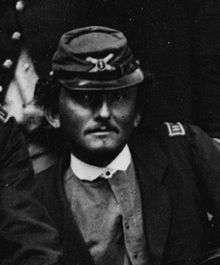William Montrose Graham, Jr.
| William Montrose Graham, Jr. | |
|---|---|
 Captain William Montrose Graham, Jr., September 1863. Library of Congress. | |
| Born |
September 28, 1834 Washington, D.C. |
| Died |
January 16, 1916 (aged 81) Wardour, Maryland |
| Place of burial | Congressional Cemetery |
| Allegiance |
United States of America Union |
| Service/branch |
United States Army Union Army |
| Years of service | 1855–1898 |
| Rank |
|
| Commands held |
2nd District of Columbia Infantry 5th Artillery Regiment Second Army Corps |
| Battles/wars | Spanish–American War |
William Montrose Graham, Jr. (September 28, 1834 – January 16, 1916), was a career soldier in the United States Army, reaching the rank of major general. He was a veteran of both the American Civil War and the Spanish–American War.
Biography
Graham was born in Washington, D.C., the son of Colonel James Duncan Graham (1799–1865) and Charlotte Meade (sister of George Gordon Meade). He married Aroostine Brewerton Ricketts in 1860 at Fortress Monroe, VA. His uncle and namesake, William Montrose Graham (1798–1847), was killed during the Mexican–American War while commanding the 11th U.S. Infantry at Molino del Rey.
The junior Graham was commissioned into the 1st Regiment of Artillery in 1855, and earned two rapid promotions to captain with the outbreak of the Civil War.
During the war, he was cited for gallantry during the Peninsula Campaign, for actions at Antietam, and for his actions at Gettysburg. Graham earned multiple brevet (honorary) promotions for these actions, including major (July 1, 1862, Malvern Hill), lieutenant colonel (September 17, 1862, Antietam), and colonel (July 3, 1863, Gettysburg). His unit, 1st U.S. Light Artillery, Battery K, was, from 1863, part of the famed U.S. Horse Artillery Brigade.
Graham served with the Regular Army until April 1865, when he accepted a commission as colonel of the 2nd District of Columbia Infantry Regiment. Awarded his final brevet of the war, to brigadier general in the Regular Army, he mustered out of the volunteers in September and returned to the regular service.
He remained in the Army after the war, serving with the 4th and 5th Artillery, rising to the rank of brigadier general in the Regular Army (May 26, 1897). At the start of the Spanish–American War in May 1898, he was promoted to major general of U.S. Volunteers. After brief service in command of the Second Army Corps at Camp Alger and Camp Meade, he retired from the Regular Army on his 64th birthday, and was honorably mustered out of the volunteers on November 30, 1898.
In 1898 he became a companion of the Pennsylvania Commandery of the Military Order of Foreign Wars.
He died in Wardour, Maryland, January 16, 1916, and was buried in the Congressional Cemetery, in Washington, D.C.
References
- Heitman, Francis B., Historical Register and Dictionary of the United States Army, From its Organization, September 29, 1789 to March 2, 1903. Washington, D.C.: Government Printing Office, 1903.
- U.S. War Department, The War of the Rebellion: A Compilation of the Official Records of the Union and Confederate Armies. Washington, D.C.: Government Printing Office, 1894.
External links
- Camp Mead in Middletown Borough, Pennsylvania.
- American Memory: Selected Civil War Photographs. Library of Congress. Prints and Photographs Division. Washington, D.C.
- Historic Congressional Cemetery, Washington, D.C.